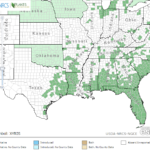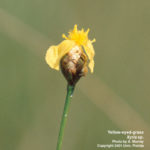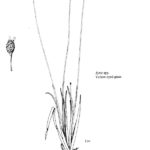Xyris spp.
USDA, NRCS. 2018. The PLANTS Database (http://plants.usda.gov, 28 March 2018). National Plant Data Team, Greensboro, NC 27401-4901 USA.
Illustration courtesy of University of Florida/IFAS Center for Aquatic and Invasive Plants. Used with permission.
What is Yellow-Eyed Grass?
Physical Characteristics
Leaves:
- Located at base
- Shiny
- 2 inches – 2 feet long
- Linear
- Strap-like
Flowers:
- Cone-like
- Bright yellow, sometimes white
- 3 petals
Fruit:
- Dry
- Many-seeded
- Does not open to release seed when ripe
Stem:
- Clustered
- 4 inches – 3 feet tall
- Taller than leaves
- Smooth or thread-like
- Growing from bulb
Where Does it Grow?
Yellow-eyed grass can be found growing alone or in colonies in moist soil.
Pros and Cons of Yellow-Eyed Grass
Yellow-eyed grass is eaten by mammals and many other animals. Submerged portions of all aquatic plants provide habitats for many micro and macro invertebrates. These invertebrates in turn are used as food by fish and other wildlife species (e.g. amphibians, reptiles, ducks, etc.). After aquatic plants die, their decomposition by bacteria and fungi provides food (called “detritus”) for many aquatic invertebrates.




